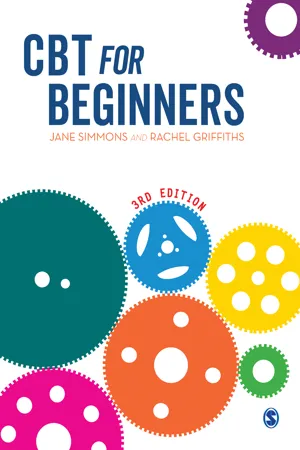
- 288 pages
- English
- ePUB (mobile friendly)
- Available on iOS & Android
CBT for Beginners
About this book
This book provides the ideal starting point for trainees and practitioners needing a no-nonsense, clear guide to the basics of CBT. It will equip themwith the knowledge and know-how, covering all the main theory and competencies to helpthem practice CBT effectively and confidently.
Focusing on case formulation, the authors show readers how to build a ?picture? of each client, using their case history to inform interventions. Features such as exercises, case dialogues, summary boxes, and further reading lists help to enhance and cement learning.
This third edition includes updated references, further reading and exercises, and new content on:
· The difficulties and drawbacks of CBT
· The differences between formal CBT and informal CBT
· The therapeutic relationship
· Further discussion of specific formulations
· Compassionate interventions with negative thoughts.
Frequently asked questions
- Essential is ideal for learners and professionals who enjoy exploring a wide range of subjects. Access the Essential Library with 800,000+ trusted titles and best-sellers across business, personal growth, and the humanities. Includes unlimited reading time and Standard Read Aloud voice.
- Complete: Perfect for advanced learners and researchers needing full, unrestricted access. Unlock 1.4M+ books across hundreds of subjects, including academic and specialized titles. The Complete Plan also includes advanced features like Premium Read Aloud and Research Assistant.
Please note we cannot support devices running on iOS 13 and Android 7 or earlier. Learn more about using the app.
Information
Table of contents
- Cover
- Half Title
- List of Digital Tools
- Title Page
- Copyright Page
- Acknowledgements
- Contents
- Illustration List
- Table List
- About the Authors
- Publisher’s Acknowledgements
- Praise for the Previous Editions
- Introduction to the Third Edition
- Part One CBT – What is it?
- 1 CBT – What is it?
- 2 Who Benefits from CBT?
- 3 The CBT Model
- 4 Levels of Cognitions (Thoughts, Beliefs and Assumptions)
- 5 Structure of Therapy and Sessions
- 6 The Therapeutic Relationship
- Part Two CBT – How do you do it?
- 7 CBT Assessment
- 8 CBT Formulation
- 9 Setting Therapy Goals
- 10 Coping Strategies
- 11 Behavioural Interventions
- 12 Cognitive Interventions: Psycho-education about Thoughts and Beliefs
- 13 Cognitive Interventions: Identifying Negative Automatic Thoughts (NATs)
- 14 Cognitive Interventions: Evaluation of Negative Automatic Thoughts or ‘Thought Challenging’
- 15 Cognitive Interventions: Working with Assumptions and Core Beliefs
- Part Three And The Rest …
- 16 Mindfulness
- 17 Problem Solving
- 18 Working with Emotions
- 19 Motivation for Change
- 20 Therapeutic Endings
- 21 Supervision
- Conclusion
- Appendices
- Appendix I Referral Criteria Handout
- Appendix II Chapter 3 Exercise
- Appendix III Formulation Sheet and Maintenance Cycle
- Appendix IV Physical Effects of Anxiety and How to Manage Them
- Appendix V Graded Practice Diary
- Appendix VI Detailed Activity Record Sheet
- Appendix VII Basic Activity Schedule
- Appendix VIII Thought Record Sheets
- Appendix IX Questions to Help Identify Negative Automatic Thoughts
- Appendix X Thinking Biases
- Appendix XI Thinking Biases Exercise
- Appendix XII Thought Evaluation Sheets
- Appendix XIII Questions to Ask When Evaluating NATs
- Appendix XIV Responsibility Chart
- Appendix XV Decisional Bias Sheet
- Appendix XVI Handout: Dealing with Setbacks during the Recovery Process
- Appendix XVII Relapse Prevention Sheet
- Appendix XVIII Ending Letters
- Appendix XIX BABCP Supervision Agreement
- References
- Index